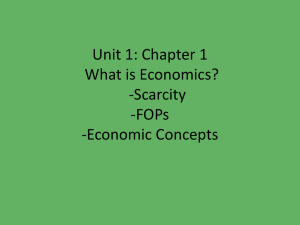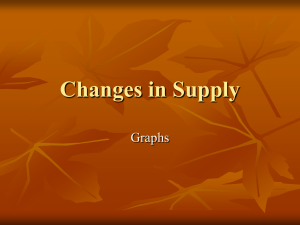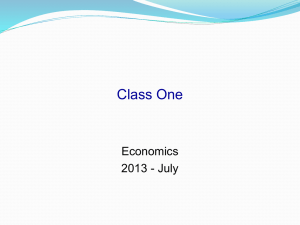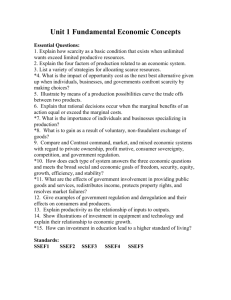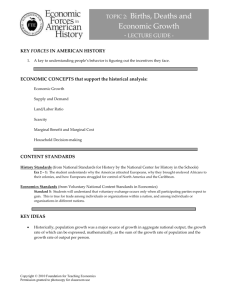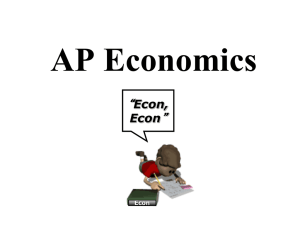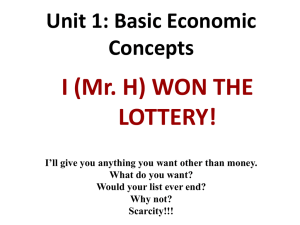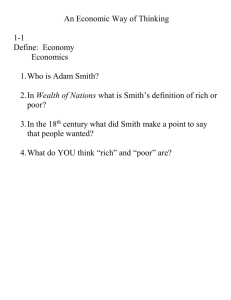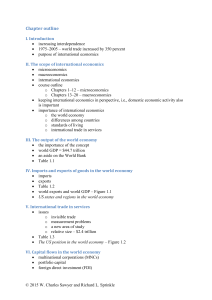ECN 112 Chapter 1 Lecture Notes
advertisement
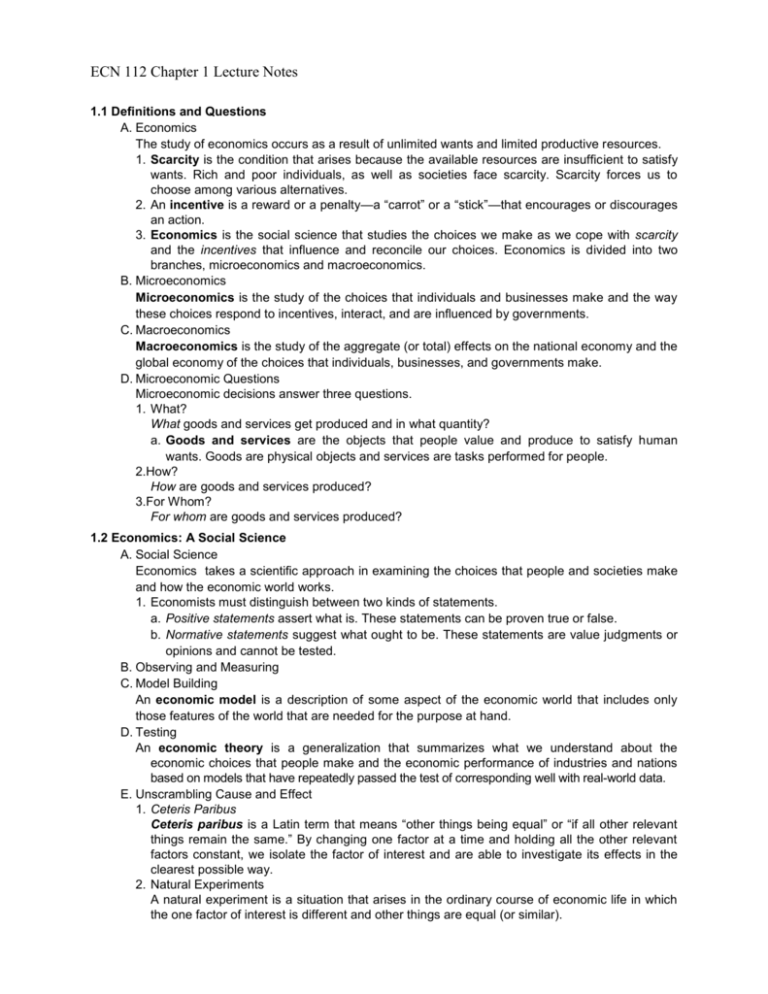
ECN 112 Chapter 1 Lecture Notes 1.1 Definitions and Questions A. Economics The study of economics occurs as a result of unlimited wants and limited productive resources. 1. Scarcity is the condition that arises because the available resources are insufficient to satisfy wants. Rich and poor individuals, as well as societies face scarcity. Scarcity forces us to choose among various alternatives. 2. An incentive is a reward or a penalty—a “carrot” or a “stick”—that encourages or discourages an action. 3. Economics is the social science that studies the choices we make as we cope with scarcity and the incentives that influence and reconcile our choices. Economics is divided into two branches, microeconomics and macroeconomics. B. Microeconomics Microeconomics is the study of the choices that individuals and businesses make and the way these choices respond to incentives, interact, and are influenced by governments. C. Macroeconomics Macroeconomics is the study of the aggregate (or total) effects on the national economy and the global economy of the choices that individuals, businesses, and governments make. D. Microeconomic Questions Microeconomic decisions answer three questions. 1. What? What goods and services get produced and in what quantity? a. Goods and services are the objects that people value and produce to satisfy human wants. Goods are physical objects and services are tasks performed for people. 2.How? How are goods and services produced? 3.For Whom? For whom are goods and services produced? 1.2 Economics: A Social Science A. Social Science Economics takes a scientific approach in examining the choices that people and societies make and how the economic world works. 1. Economists must distinguish between two kinds of statements. a. Positive statements assert what is. These statements can be proven true or false. b. Normative statements suggest what ought to be. These statements are value judgments or opinions and cannot be tested. B. Observing and Measuring C. Model Building An economic model is a description of some aspect of the economic world that includes only those features of the world that are needed for the purpose at hand. D. Testing An economic theory is a generalization that summarizes what we understand about the economic choices that people make and the economic performance of industries and nations based on models that have repeatedly passed the test of corresponding well with real-world data. E. Unscrambling Cause and Effect 1. Ceteris Paribus Ceteris paribus is a Latin term that means “other things being equal” or “if all other relevant things remain the same.” By changing one factor at a time and holding all the other relevant factors constant, we isolate the factor of interest and are able to investigate its effects in the clearest possible way. 2. Natural Experiments A natural experiment is a situation that arises in the ordinary course of economic life in which the one factor of interest is different and other things are equal (or similar). 3. Statistical Investigations. a. Correlation is the tendency for the values of two variables to move in a predictable and related way. b. The post hoc fallacy is the error of reasoning that a first event causes a second event because the first occurred before the second. 4. Economic Experiments Economic experiments put real subjects in a decision-making situation and vary the influence of interest to discover how the subjects respond to one factor at a time. 1.3 The Economic Way of Thinking A. Rational Choice A rational choice is a choice that uses the available resources to most effectively satisfy the wants of the person making the choice. A rational choice compares costs and benefits. B. Cost: What You Must Give Up The cost of a choice is measured by what must be given up. The opportunity cost of something is the best thing you must give up to get it. 1. A sunk cost is a previously incurred and irreversible cost. A sunk cost is irrelevant in making a choice. C. Benefit: Gain Measured By What You Are Willing To Give Up The benefit of a something is the gain or pleasure it brings. Economists measure the benefit of something by what a person is willing to give up to get it.. D. On the Margin A choice on the margin is a choice that is made by comparing all the relevant alternatives systematically and incrementally. 1. Marginal Cost The marginal cost is the opportunity cost that arises from a one-unit increase in activity. The marginal cost of something is what you must give up to get one more unit of it. 2. Marginal Benefit The marginal benefit is the benefit that arises from a one-unit increase in an activity. The marginal benefit of something is measured by what you are willing to give up to get one more unit of it. 3. Making a Rational Choice When making a rational choice, the decision maker compares the marginal cost of the choice to the marginal benefit of the choice. If the marginal benefit is greater than the marginal cost, the choice is made. If the marginal cost is greater than the marginal benefit, the choice is not made. E. Responding to Incentives People are motivated by incentives to take a particular action. The incentive, or inducement, can be a marginal benefit or a marginal cost. 1.4 Why Economics Is Worth Studying A. Understanding By studying economics you can understand the economic ideas that are pervasive in your life. B. Expanded Career Opportunities People that excel at identifying and solving problems earn high incomes. Studying economics encourages you to engage in these activities and to learn useful economic concepts. C. The Costs of Studying Economics The costs of studying economics include the forgone knowledge that could be gained by taking another class or enjoying leisure time. D. Benefits Versus Costs Deciding whether you should study economics means you must compare your costs and benefits of taking an economics course.
